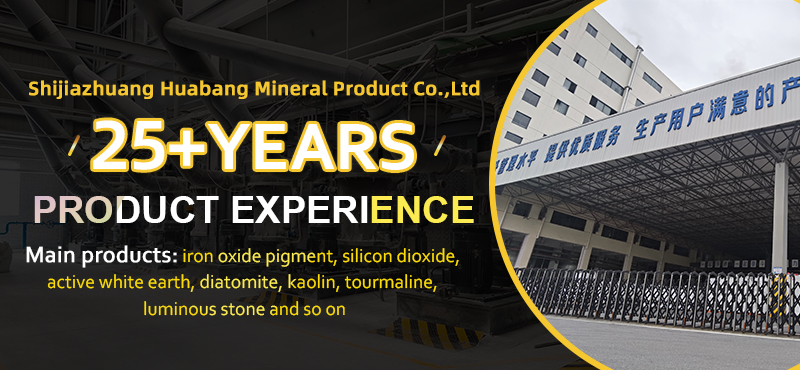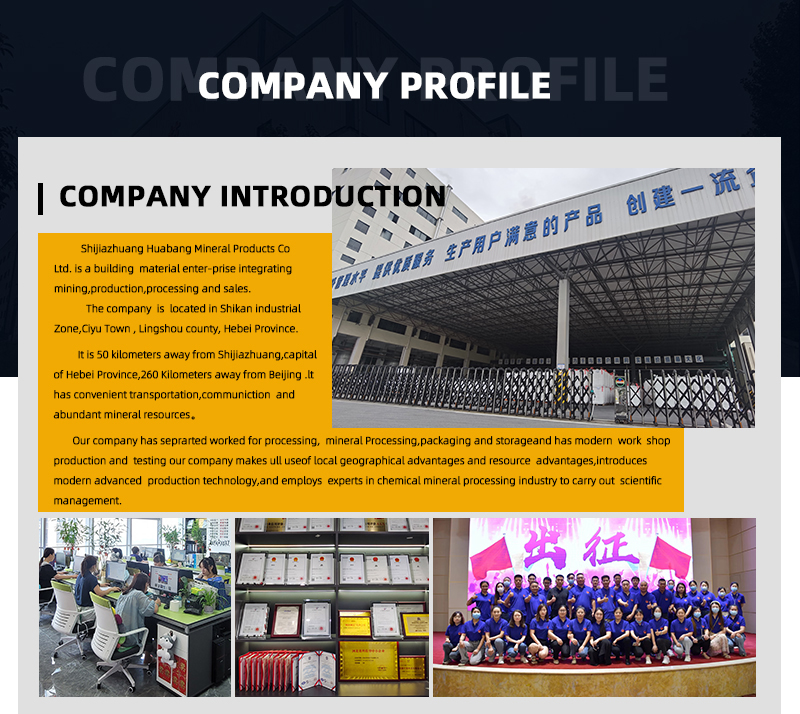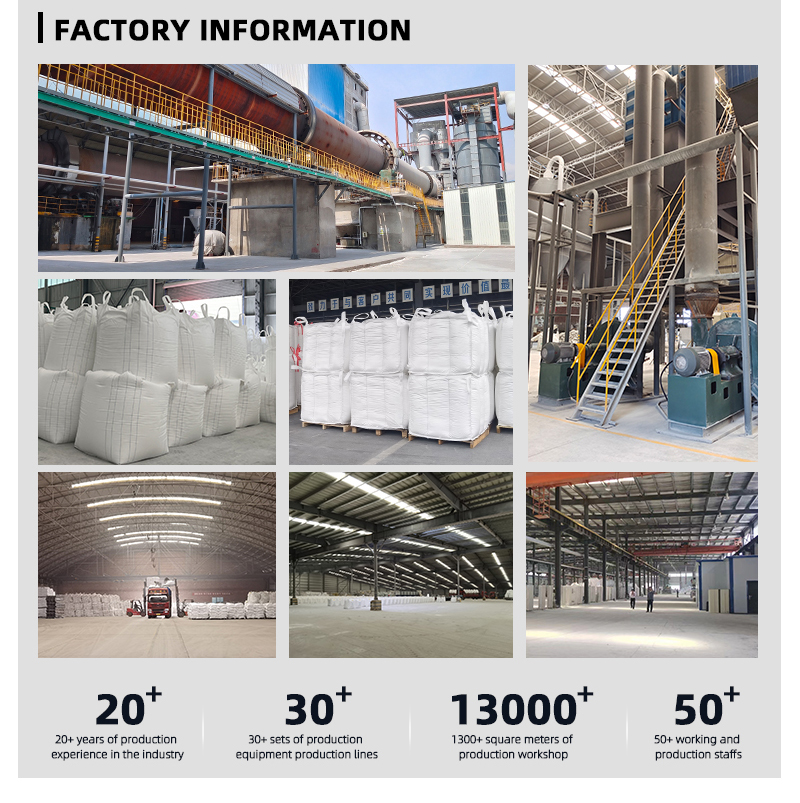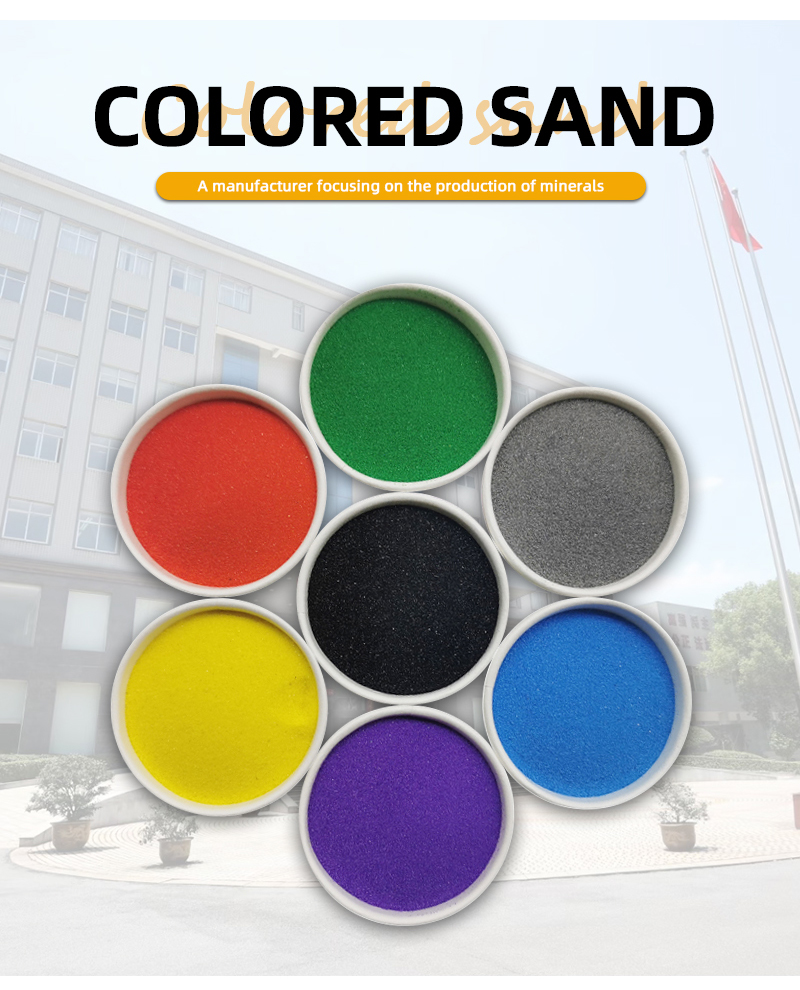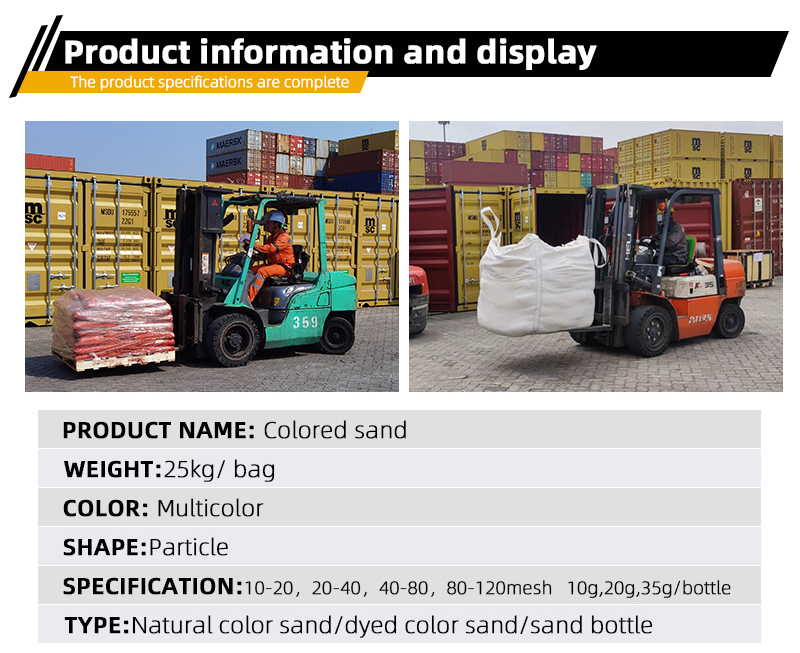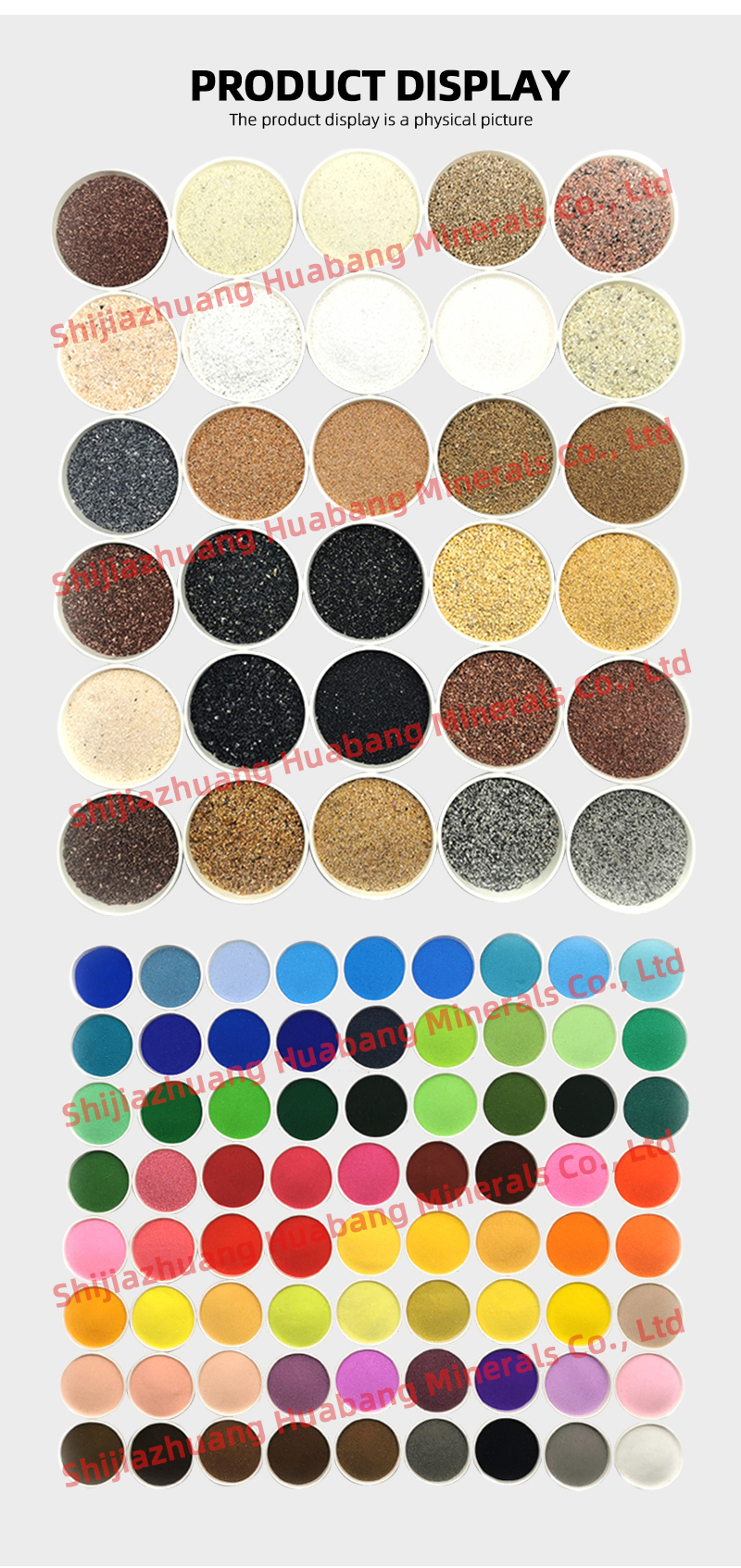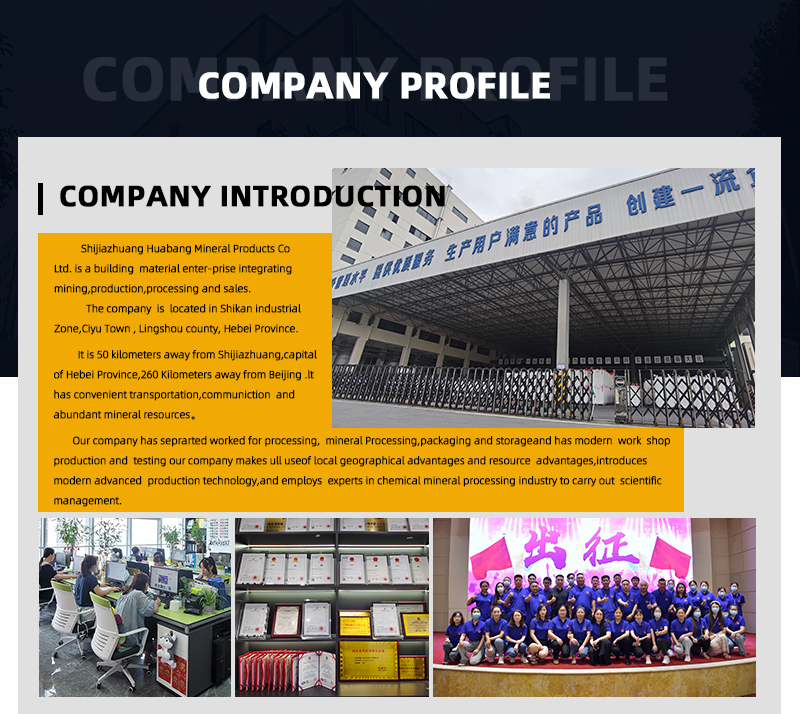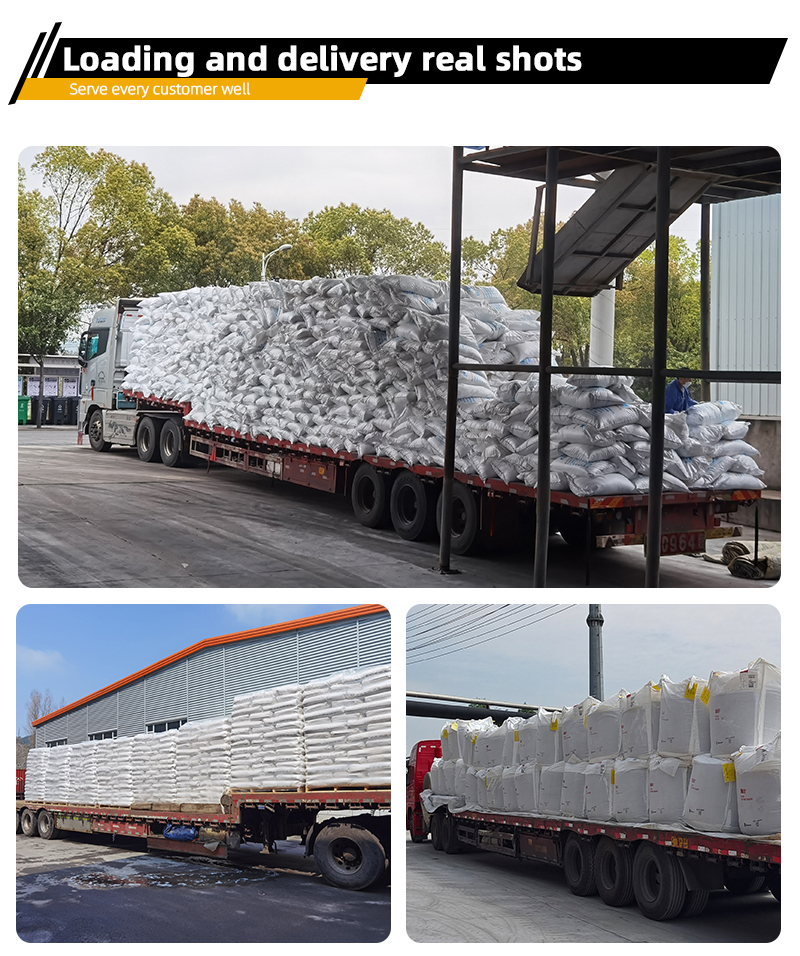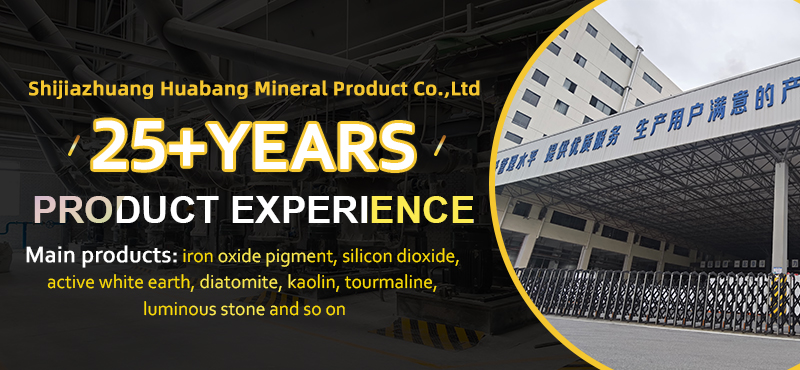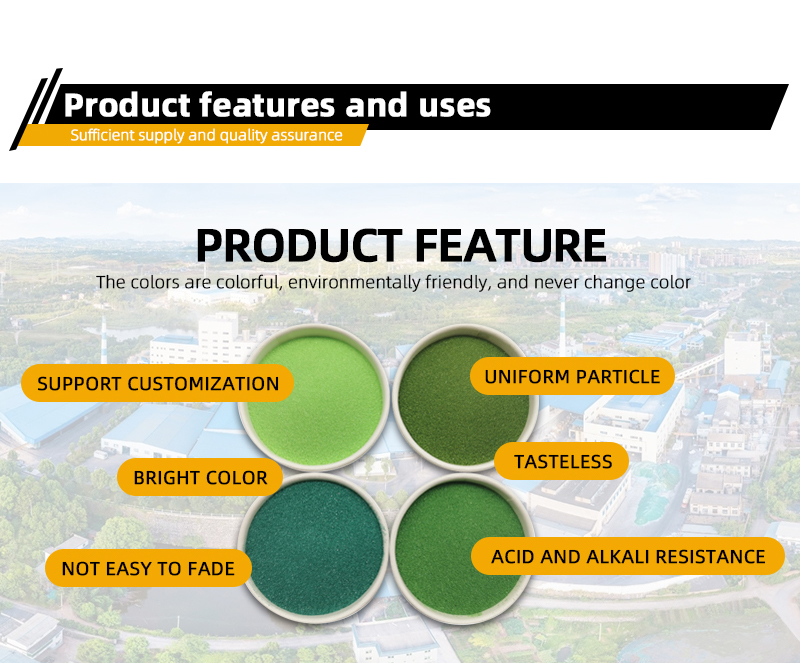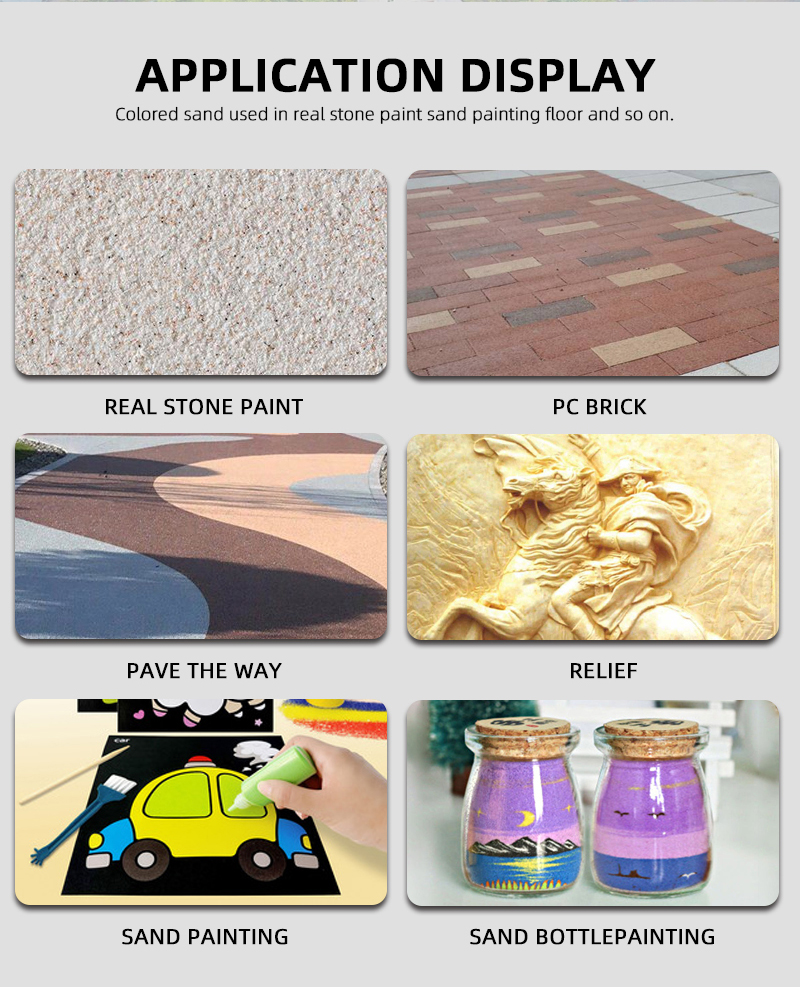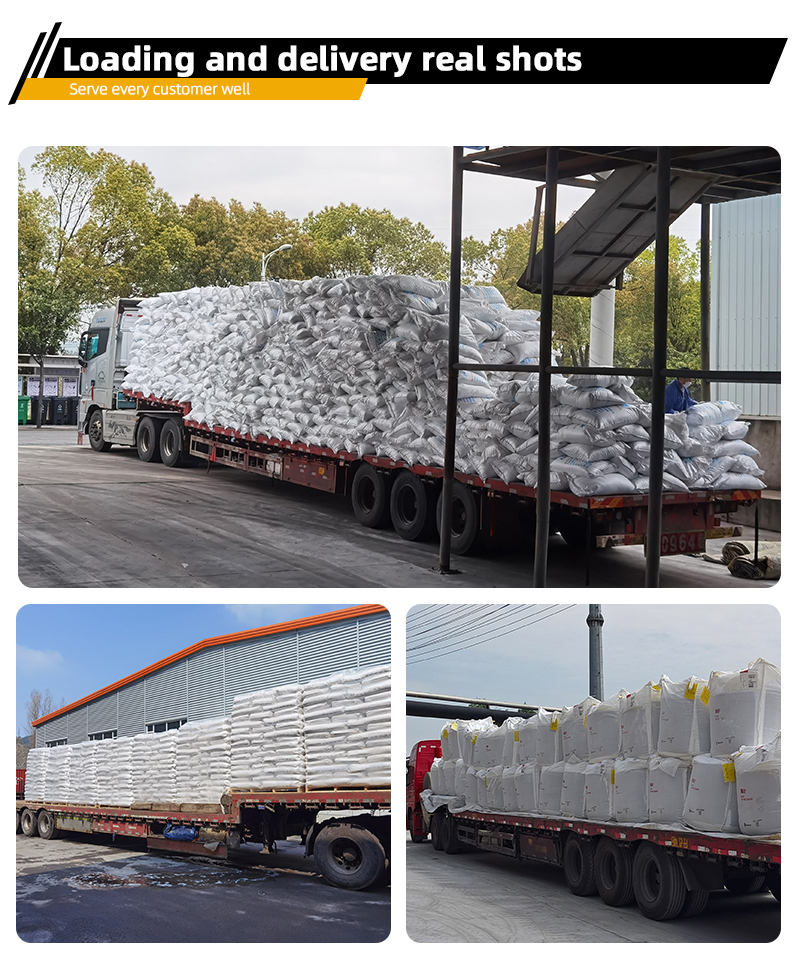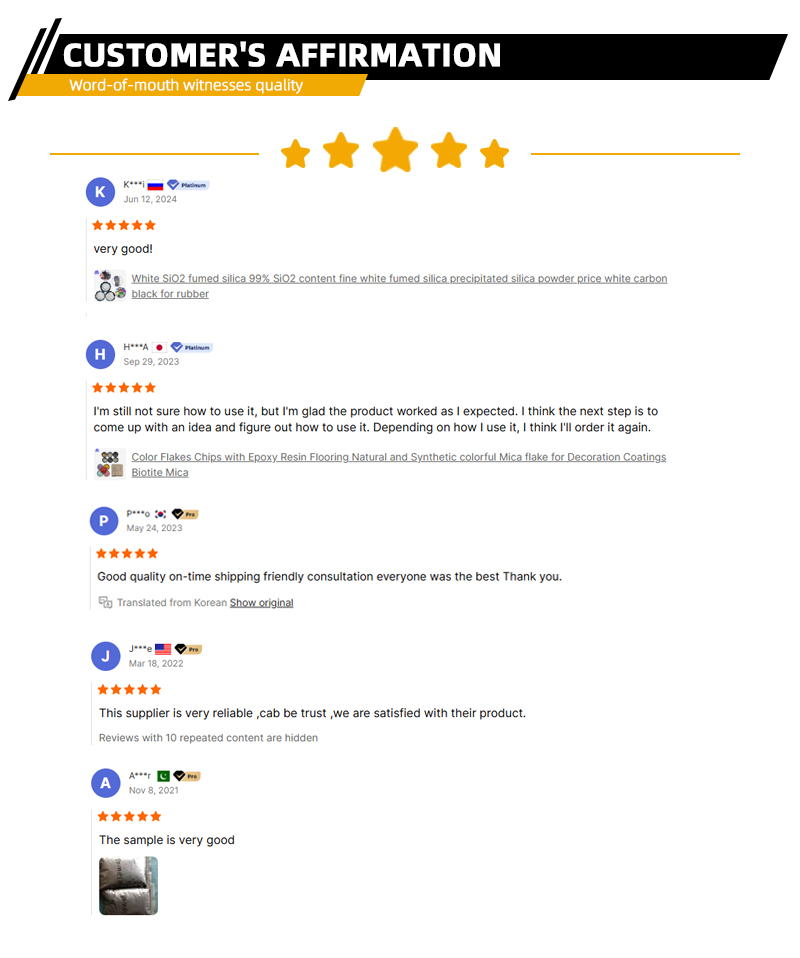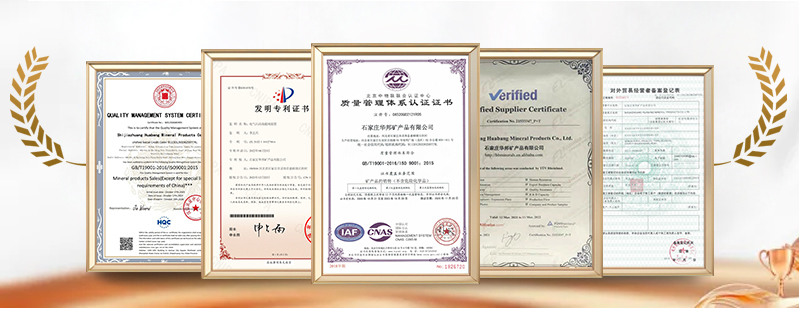-

Colored sand for sustainable construction eco friendly decoration durable surface application architectural adornment landscape design enhancement industrial coating support decorative craft creation
Colored sand emerges as core material in global construction, decoration, and industrial fields, bridging natural mineral resources and human creative needs. Unlike ordinary sand with monotonous gray hue, colored sand gains vivid tones through natural geological processes or eco-friendly artificial pigmentation, carrying dual advantages of natural texture and stable color. Its application spans from grand architectural facades to delicate craftworks, from urban landscape projects to industrial surface treatments, forming unique industrial chain that aligns with sustainable construction and eco-friendly decoration trends. As industries pursue low-carbon transformation and consumers demand materials with both aesthetic value and durability, colored sand breaks through traditional application boundaries, integrating into urban renewal, rural revitalization, and high-end craft manufacturing scenarios, demonstrating enduring vitality and innovative potential.Raw material foundation of colored sand determines its texture and color expression, with two main sources: natural colored sand and synthetic colored sand. Natural colored sand originates from natural mineral deposits formed through millions of years of geological evolution—quartz sand, feldspar sand, and marble sand are primary carriers, with colors derived from trace elements in minerals or weathering effects. Red colored sand from Yunnan, China, gains its hue from iron oxide trace elements in quartz sand; yellow colored sand from Arizona, USA, comes from feldspar sand containing potassium and sodium oxides; green colored sand from Norway is formed by serpentine mineral weathering, carrying unique emerald tones. Mining of natural colored sand adheres to strict ecological protection standards: in Norway’s serpentine mines, miners adopt selective digging to avoid large-scale vegetation destruction; after extraction, topsoil is preserved and reused for reforestation, with native moss and shrubs planted to restore soil stability. Synthetic colored sand, by contrast, uses high-purity natural sand (such as quartz sand with low impurity content) as base material, then undergoes surface pigmentation with eco-friendly inorganic pigments. Pigments used are mainly iron oxide, titanium dioxide, and chromium oxide—non-toxic, light-resistant, and chemically stable, ensuring colored sand retains color without releasing harmful substances. This dual raw material system not only secures diverse color supply but also adapts to different application scenarios: natural colored sand is preferred for projects pursuing earthy texture, while synthetic colored sand dominates fields requiring uniform color and high consistency.Production process of colored sand combines natural processing and modern eco-friendly technology, ensuring product quality while minimizing environmental impact. For natural colored sand, mined mineral sand undergoes physical processing: first, crushing into coarse particles using jaw crushers, then screening to remove oversized impurities; subsequent washing with clean water removes dust and clay, preserving natural mineral luster; drying in solar-powered drying yards (instead of fossil fuel heaters) reduces energy consumption; final screening classifies particles into different sizes—fine sand (0.1-0.3mm) for coatings and crafts, medium sand (0.3-0.6mm) for landscape paving, coarse sand (0.6-1.2mm) for architectural aggregates. Synthetic colored sand production follows strict environmental procedures: base sand is first purified to remove impurities that affect pigment adhesion; then mixed with inorganic pigments and small amounts of eco-friendly binders in rotating drums, ensuring uniform pigment coating on sand surface; curing at moderate temperatures (avoiding high-temperature calcination that increases energy use) enhances color fastness; final cooling and screening ensure particle size consistency. Both production modes avoid toxic chemical additives and excessive energy consumption: natural colored sand processing uses only physical methods, while synthetic colored sand uses water-based binders and low-temperature curing, embodying eco-friendly production principles.Core characteristics of colored sand—natural texture, color stability, durability, and compatibility—make it indispensable across diverse industries, setting it apart from ordinary decorative materials. Natural texture is most distinctive trait of colored sand: each particle retains natural mineral lines and roughness, creating unique tactile and visual effects. When used in architectural facades, colored sand forms matte or semi-matte surfaces that reflect soft light, avoiding glare caused by smooth materials; in craftworks, its granular texture adds three-dimensional sense, making works more lifelike. Color stability is another key advantage: natural colored sand’s hues come from inherent mineral components, resisting UV radiation and weathering; synthetic colored sand uses inorganic pigments with strong light resistance—colored sand used in outdoor landscapes retains original tone for over 15 years, while organic-pigmented materials might fade to pale shades within 3 years. Durability of colored sand is verified in practical applications: when mixed into concrete, it increases surface abrasion resistance by 40%, making it suitable for high-traffic areas like shopping mall floors; when used as coating additive, it enhances film hardness, preventing scratches and cracks. Compatibility is also notable—colored sand mixes seamlessly with concrete, mortar, paint, epoxy resin, and plastic, adapting to diverse processing techniques such as spraying, paving, casting, and bonding. This versatility allows colored sand to integrate into multiple industries, from construction to crafts, meeting varied functional and aesthetic needs.Construction industry integrates colored sand into diverse projects, from sustainable buildings to historical renovations, enhancing both functionality and aesthetics. Green building projects, a core part of sustainable construction, widely use colored sand in exterior and interior decorations. For example, low-carbon office buildings in Berlin, Germany, use red and yellow natural colored sand mixed into exterior wall mortar; the earthy hues blend with surrounding urban greenery, while sand’s thermal insulation performance reduces indoor heating demand by 30%. Historical building renovations prioritize natural colored sand to maintain architectural authenticity—restoration of ancient castles in France uses gray and brown natural colored sand to replicate original stone wall textures, with sand particle size adjusted to match historical masonry, ensuring consistency in touch and appearance. Residential construction uses colored sand in decorative elements: yellow synthetic colored sand mixed into floor tiles creates warm, comfortable living spaces; red colored sand used in kitchen backsplashes adds vivid focal points without losing natural texture. Infrastructure projects like pedestrian bridges and plazas use colored sand in paving materials: blue and green colored sand mixed into concrete paving blocks form pattern resembling riverbeds, enhancing urban landscape continuity; coarse colored sand added to anti-slip coatings on bridge surfaces improves walking safety in rainy weather. Construction engineers value that colored sand is compatible with various construction materials, including cement, lime, and gypsum, without affecting structural strength, while adding unique aesthetic value.Landscape design industry relies on colored sand to create natural, durable outdoor spaces that blend with ecological environments. Urban parks and gardens are major application scenarios: brown natural colored sand is used in dry landscape gardens to simulate sand dunes, matching with rocks and succulents to create Zen-style spaces; blue synthetic colored sand lines artificial streams, mimicking clear water effects with its vivid hue. Children’s playgrounds use colored sand in safety surfaces and decorative elements: red and yellow fine colored sand mixed into rubber mats forms soft, non-toxic playing surfaces; colored sand-filled plastic modules spell out cartoon patterns, attracting children while ensuring safety. Residential courtyard design uses colored sand in diverse ways: white colored sand surrounds flower beds to highlight plant colors; black colored sand paves small paths, creating contrast with green lawns. Public waterfront projects use colored sand to resist water erosion: in Singapore’s Marina Bay, brown and gray colored sand mixed into concrete revetments forms natural stone-like surfaces that withstand wave impact, while blending with coastal landscape. Landscape architects emphasize that colored sand’s natural texture and stable color reduce maintenance needs—outdoor colored sand decorations rarely require repainting or replacement, even after years of rain and sunlight exposure.Decorative and craft industries use colored sand to create unique works that combine aesthetics and durability, spanning interior decoration, handcrafts, and art installations. Interior decoration trends favor natural elements, making colored sand popular in wall finishes and decorative art. Boutique hotels in Tokyo, Japan, use green and brown natural colored sand in lobby wall murals; artists spread colored sand on adhesive backgrounds to form mountain and forest patterns, with granular texture adding depth and realism. Residential interiors use colored sand in custom decorations: blue synthetic colored sand mixed into epoxy resin creates desktop with ocean-like appearance; red colored sand embedded in wooden photo frames adds natural warmth. Handcraft manufacturing is major application field for colored sand: craft makers in Mexico use fine colored sand to create sand paintings, layering different hues to form vivid folk patterns; in China, colored sand is filled into glass bottles to make three-dimensional landscape ornaments, with color combinations reflecting seasonal changes. Public art installations use colored sand for temporary or permanent displays: in Paris’s Champs-Élysées, artists used 100 tons of colored sand to create giant ground murals depicting city history, which remained intact for two months despite heavy foot traffic; permanent artworks in urban squares use colored sand mixed into concrete to form abstract patterns, resisting weathering and retaining artistic value for decades.Industrial manufacturing sectors beyond construction and decoration integrate colored sand to enhance product performance and appearance. Coatings and paints industry uses colored sand as functional additive: fine red colored sand added to exterior wall paints creates textured finishes that hide wall defects; black colored sand mixed into industrial coatings for machinery enhances wear resistance and heat dissipation. Plastics and rubber industry uses colored sand to add texture and color: yellow colored sand mixed into plastic outdoor furniture prevents UV-induced fading while adding non-slip texture; green colored sand added to rubber floor mats for gyms increases friction and durability. Ceramic industry uses colored sand in glaze formulations: brown natural colored sand mixed into ceramic glazes creates rustic floor tiles mimicking natural stone; blue synthetic colored sand added to porcelain vases forms unique speckled patterns. Packaging industry uses colored sand in eco-friendly packaging materials: colored sand embedded in cardboard boxes for luxury goods adds tactile texture, enhancing brand image while remaining recyclable. Manufacturers across sectors appreciate that colored sand is non-toxic and complies with global safety standards, making it suitable for consumer products ranging from children’s toys to household appliances.Urban public facility construction leverages colored sand to create durable, aesthetically pleasing spaces that serve community needs. Public transportation hubs, such as subway stations and bus terminals, use colored sand in decorative and functional elements: gray synthetic colored sand mixed into wall finishes hides dirt and reduces cleaning frequency; red and yellow colored sand used in floor markings guides passenger flow clearly. Street furniture, including benches and trash cans, uses colored sand in surface treatments: brown colored sand mixed into concrete benches resists rain and sun damage, maintaining natural appearance for years; green colored sand added to plastic trash can surfaces adds visual appeal while preventing scratches. Urban signboards and public artworks use colored sand for high visibility and durability: blue colored sand mixed into epoxy resin forms traffic sign backgrounds that remain vivid in strong sunlight; colored sand used in community murals depicts local culture, with stable colors resisting graffiti and weathering. Urban planners note that colored sand’s low maintenance cost and natural aesthetics align with smart city goals of efficient resource utilization and human-centric design.Quality control of colored sand runs through entire production and application process, ensuring product consistency and performance. Raw material inspection focuses on purity and color stability: natural mineral sand is tested for impurity content using X-ray fluorescence spectrometry; synthetic base sand is analyzed for particle size distribution to ensure pigment adhesion. In-process testing monitors key parameters: particle size is measured with laser diffraction analyzers; color coordinates are checked with spectrophotometers to ensure batch uniformity. For synthetic colored sand, additional tests include pigment adhesion (rubbing sand particles to check for color loss) and light resistance (exposing samples to simulated sunlight for 1000 hours). Final product testing includes durability evaluations: abrasion resistance testing uses rotating sandpaper to assess surface wear; water resistance testing soaks samples in water for 72 hours to check for color bleeding. Manufacturers provide detailed quality reports for each batch, including test data and production records, to ensure traceability. Third-party certification bodies, such as ISO and ASTM, conduct regular audits to confirm that quality control systems meet international standards.

-

Fine Grained Colored Sand from Hebei China with Strong Adhesion for Handicraft Making and Decorative Mosaic Art Materials
Fine grained colored sand from Hebei, China, has firmly established itself as a versatile and sought-after material across numerous creative and industrial sectors. Its global renown stems from the unique qualities that make it a top choice for a wide array of applications, captivating the imaginations of artists, designers, and DIY enthusiasts alike.The allure of Hebei’s colored sand lies in its exceptional characteristics. Sourced from carefully selected marble and granite, this sand undergoes a meticulous and elaborate production process. Through repeated grinding and screening, the raw materials are transformed into ultra-fine particles. These particles maintain their shape with remarkable precision and adhere seamlessly to various substrates, making them ideal for countless projects. Whether in its natural form or dyed to a vivid hue, the sand offers a vast palette of colors, enabling creators to bring their most imaginative visions to life.One of the hallmarks of Hebei’s colored sand production is the unwavering focus on particle consistency. The sand goes through multiple stages of screening to eliminate any coarse grains, ensuring a uniform texture. This attention to detail is crucial, especially in projects that demand precision, such as intricate artworks and detailed designs. For the dyed varieties, heat-set pigments are used in the coloring process. These pigments bond strongly with the sand particles, providing excellent colorfastness. This means that the colors remain vibrant and do not bleed, even when the sand is combined with adhesives or exposed to moisture, making it suitable for long-lasting creations.In the world of art, Hebei’s colored sand serves as a medium for creating stunning mosaic murals. These murals tell stories and showcase intricate patterns, adorning walls with beauty and creativity. The sand also enhances decorative glassware, adding splashes of color that catch and reflect light in enchanting ways. In the realm of handmade jewelry, its fine texture allows jewelers to craft elaborate and detailed designs, turning simple materials into works of art. When paired with specialized mosaic adhesives, the sand adheres securely to surfaces like ceramic, wood, and glass, ensuring that the finished art pieces endure the passage of time. The natural color variations within the sand add an extra layer of depth and uniqueness to artworks, creating visual effects that are truly one-of-a-kind and impossible to replicate with synthetic alternatives.Beyond the artistic domain, Hebei’s colored sand has made significant inroads into interior design and architectural projects. It is employed to create distinctive flooring designs that add a sense of luxury and personalization to spaces. In garden and landscape design, the sand is used to construct decorative pathways, intricate patterns in rock gardens, and visually appealing borders. Its ability to withstand outdoor elements while retaining its color makes it a preferred choice for these applications, enhancing the aesthetic appeal of outdoor environments.The versatility of Hebei’s colored sand extends to the realm of DIY projects, where it has become a favorite among hobbyists and enthusiasts. It is used for a broad spectrum of crafts, from personalizing photo frames and coasters to designing custom home decor items. The availability of small-batch packaging makes it accessible for individual projects, while bulk options cater to large-scale craft manufacturers and commercial ventures. This ensures that regardless of the project size, the right quantity of colored sand can be obtained.Hebei suppliers are attuned to the diverse needs of their customers. They offer a range of packaging options, from compact packs suitable for individual artists to large containers for mass production. Sample kits featuring various color combinations are provided, allowing creators to experiment and select the perfect shades for their projects. An efficient logistics network is in place to ensure that the sand reaches customers in perfect condition. The packaging is designed to preserve the sand’s fine texture and prevent clumping, guaranteeing that it arrives ready for use.In the world of educational projects, Hebei’s colored sand has proven to be an excellent teaching aid. It helps students understand concepts like color theory, texture, and composition in art classes. In craft workshops, it encourages hands-on learning and creativity, enabling participants to explore different techniques and express their ideas. Its non-toxic nature makes it safe for use in educational settings, allowing students of all ages to engage with it without concerns.For event planners and decorators, Hebei’s colored sand offers a unique way to create memorable and visually striking setups. It can be used to design custom centerpieces, stage backdrops, and interactive installations. The sand’s vibrant colors and fine texture add a touch of elegance and creativity to events, making them stand out from the ordinary. Whether it’s a wedding, corporate event, or festival, the colored sand can be tailored to fit the theme and enhance the overall atmosphere.In the realm of product design, Hebei’s colored sand is finding its way into a variety of items. It is used to add decorative elements to stationery, such as notebooks and greeting cards, making them more appealing to consumers. In the realm of home furnishings, it can be incorporated into items like vases, lampshades, and picture frames, giving them a unique and artisanal touch. The sand’s ability to blend seamlessly with different materials allows designers to create products that are both functional and aesthetically pleasing.The cultural significance of Hebei’s colored sand cannot be overlooked. It has become an integral part of local art and craft traditions, passed down through generations. Artisans in Hebei take pride in their craftsmanship, using the colored sand to create pieces that reflect the region’s rich heritage and cultural identity. These traditional art forms not only preserve the history and culture of the area but also attract tourists who are eager to experience and purchase authentic handmade items.As the global demand for unique, handmade art and distinctive decoration continues to rise, Hebei’s fine grained colored sand is set to remain a staple material for creative professionals. Its superior quality, versatility, and extensive color range make it an essential resource for anyone looking to infuse their projects with color and creativity. Whether it’s a small-scale art piece or a large-scale design endeavor, Hebei’s colored sand offers endless possibilities for bringing ideas to life and creating something truly remarkable. Its influence extends far beyond the regions where it is produced, making a mark in the global creative and industrial landscape. -

Colorful Sand for Aquarium and Terrarium Landscaping: Creating Natural, Vibrant Habitats for Aquatic and Terrestrial Pets
Aquarium and terrarium enthusiasts increasingly seek ways to create natural, visually appealing habitats for their pets— from fish and shrimp to reptiles and amphibians. Colorful sand has become a popular choice for landscaping these enclosures, offering a safe, natural-looking substrate that enhances the habitat’s aesthetic while supporting the health of the animals. Unlike synthetic substrates that may leach chemicals or disrupt water parameters, high-quality colorful sand is inert, non-toxic, and mimics the natural environments of aquatic and terrestrial pets, making it suitable for a wide range of enclosures.For aquariums, colorful sand serves as a functional and decorative substrate that supports aquatic life while enhancing the tank’s appearance. Fish like cichlids (which inhabit rocky, sandy lakes in Africa) or tetras (from Amazonian rivers with sandy bottoms) thrive in environments with sand substrates, as it allows them to sift through the sand for food or create nests. Colorful sand for aquariums is carefully processed to be inert— it does not alter water pH, hardness, or ammonia levels, ensuring a stable environment for fish. A common choice for freshwater aquariums is natural-looking colorful sand in shades of beige, tan, or light brown, which mimics the riverbeds or lake bottoms where many fish species originate. However, more vibrant hues like blue or green are also used in decorative aquariums— a hobbyist in Los Angeles created a “coral reef” themed freshwater tank using blue colorful sand as the substrate, paired with artificial coral and tropical fish, resulting in a visually striking display that won a local aquarium competition.Colorful sand also supports the health of aquarium plants and invertebrates. Aquatic plants like Amazon swords or Java ferns root easily in sand substrates, which allow their roots to spread and absorb nutrients. Unlike gravel, which can compact and restrict root growth, sand provides a loose, porous environment that promotes healthy plant development. Invertebrates like shrimp or snails also benefit from colorful sand— they sift through the sand to find algae or leftover food, and the smooth particles prevent damage to their delicate exoskeletons. A study by an aquarium research group found that shrimp kept in sand substrates had a 25% higher survival rate compared to those in gravel, due to the sand’s gentle texture and ability to support natural foraging behaviors.For terrariums housing reptiles (like bearded dragons or leopard geckos) or amphibians (like frogs or salamanders), colorful sand creates a naturalistic substrate that supports their unique needs. Desert-dwelling reptiles, such as bearded dragons, require a sandy substrate that mimics their arid habitat— colorful sand in shades of yellow, orange, or light brown is ideal, as it allows the reptiles to burrow (a natural behavior that helps them regulate body temperature). The sand’s particle size (1-3 mm) is small enough to allow burrowing but large enough to prevent impaction (a common health issue where reptiles ingest substrate, leading to digestive blockages). A reptile breeder in Miami used orange colorful sand in their bearded dragon terrariums: the sand not only looked like the Australian outback (the natural habitat of bearded dragons) but also encouraged the dragons to burrow, resulting in healthier, more active pets.Amphibian terrariums, which require higher humidity, also benefit from colorful sand— when mixed with coconut fiber or sphagnum moss, it creates a moisture-retentive substrate that supports species like dart frogs or axolotls. The sand’s inert nature prevents it from releasing harmful substances even in damp conditions, and its color can be chosen to match the terrarium’s theme— a hobbyist created a “rainforest floor” themed terrarium for dart frogs using dark green and brown colorful sand, paired with live plants and moss, creating a habitat that closely resembles the frogs’ natural tropical environment.When selecting colorful sand for aquariums or terrariums, safety and quality are paramount. The sand must be non-toxic, with no heavy metals, dyes, or chemicals that could harm pets— look for products that meet standards like the CPSC’s toy safety guidelines (even though it’s not a toy, these standards ensure low toxicity) or aquarium-specific certifications from organizations like the Global Aquaculture Alliance. The sand should also be washed and rinsed thoroughly to remove dust or debris, which can cloud aquarium water or irritate reptile skin. For aquariums, it’s important to choose sand that is “aqua-safe”— tested to ensure it does not dissolve or leach minerals into the water. For terrariums, the sand should be heat-resistant, as many reptile enclosures use heat lamps that can raise temperatures to 30-40°C.Maintenance of colorful sand substrates is simple and straightforward. In aquariums, the sand should be vacuumed regularly (using a gravel vacuum with a gentle suction setting) to remove waste and prevent the buildup of ammonia. The sand does not need to be replaced frequently— with proper maintenance, it can last 2-3 years. In terrariums, the sand should be spot-cleaned daily to remove waste, and the entire substrate should be replaced every 6-12 months to prevent the buildup of bacteria or mold. For desert reptile terrariums, the sand should be sifted monthly to remove debris and maintain its loose texture.In summary, colorful sand has become a versatile, safe substrate for aquarium and terrarium landscaping, enhancing the appearance of enclosures while supporting the health and natural behaviors of aquatic and terrestrial pets. As more hobbyists prioritize naturalistic habitats, colorful sand provides a way to create beautiful, functional environments that meet the unique needs of different pet species. -

Colored sand for roof decoration coffee shop decoration floor laying flower bed decoration
Colored sand, a vibrant and versatile material, consists of natural or synthetic granules dyed to achieve vivid hues. Natural variants are derived from minerals like quartz, feldspar, and mica, mined in regions such as the U.S., China, and India. Synthetic colored sand is often produced by coating silica sand with inorganic or organic pigments, allowing precise color control.The manufacturing process for natural colored sand involves crushing, washing, and sieving raw minerals to remove impurities, followed by pigmentation through methods like dyeing or sintering. Synthetic sand undergoes surface treatment to ensure color adhesion and durability. Key properties include chemical resistance, UV stability, and particle uniformity, which vary based on application needs.
-

Colored sand for wear resistant flooring materials shopping center industrial plant office building
Colored sand is a versatile granular material available in natural and artificial forms. Natural colored sand is extracted from rocks and minerals containing pigments. For example, iron oxide gives it red and brown shades, while manganese can produce black or purple hues. After mining, the ore undergoes crushing, sieving, and washing to achieve the desired particle size and purity.
Artificial colored sand, on the other hand, is made by coating or dyeing base materials, usually quartz sand. Advanced pigmentation techniques ensure long – lasting, vibrant colors and consistent quality.
This material has diverse applications. In landscaping, it creates eye – catching pathways and garden beds. Artists use it in sand paintings and glass art. In construction, it adds color to concrete, plaster, and paint, enhancing the visual appeal of buildings. Additionally, it is popular in DIY projects and educational activities due to its rich colors and ease of use.
-

-

Exploring the versatility of colored sand: applications aesthetics and sustainability in various fields
Colored sand, also known as decorative sand, is a versatile material widely used in landscaping, arts and crafts, and construction projects. It adds a vibrant and eye-catching touch to various settings, enhancing aesthetic appeal and creating unique visual effects. The particles of colored sand come in a wide range of hues, from subtle pastels to bold, vibrant shades, allowing for endless design possibilities.
In landscaping, colored sand is often used in garden beds, flower pots, and walkways to create patterns, borders, and accents. It can be mixed with other materials like gravel or mulch to add texture and depth to outdoor spaces. In the realm of arts and crafts, colored sand is a popular medium for creating intricate mosaic designs, sand paintings, and other decorative artworks.
Additionally, colored sand finds applications in construction, particularly in the production of glass and ceramics, where it can add color and texture to the finished product. Its use in various fields demonstrates its versatility and the many ways it can be incorporated into creative and functional designs.
-

-
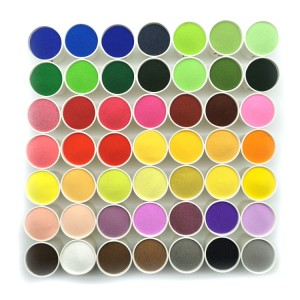
Huabang Wholesale 10-20 mesh 20-40mesh Color Sand for Construction Building Paint
Colored sand is divided into natural colored sand, sintered colored sand, and dyed colored sand. Its characteristics are: bright colors, acid and alkali resistance, UV resistance, and no fading.
Type: natural color sand, colored sand.
size: 10-20.20-40.40-80.80-120.120-180.200mesh.
-
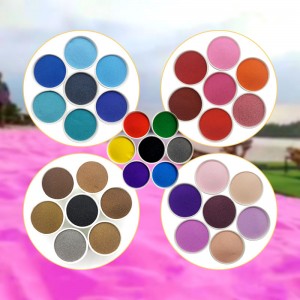
Multicolor Sand Colored Sand Natural Mineral Children’s Play Sand Dyed Color Sand Silica Sand Factory
Colored sand is divided into natural colored sand, sintered colored sand, and dyed colored sand. Its characteristics are: bright colors, acid and alkali resistance, UV resistance, and no fading.
Type: natural color sand, colored sand.
size: 10-20.20-40.40-80.80-120.120-180.200mesh.
-
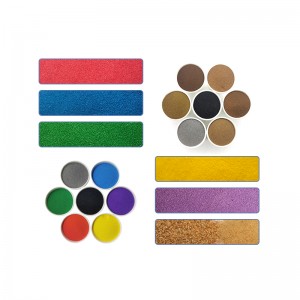
Multi coloured sand light colored sand black sand for real stone paint
Colored sand is divided into natural colored sand, sintered colored sand, and dyed colored sand. Its characteristics are: bright colors, acid and alkali resistance, UV resistance, and no fading.
Type: natural color sand, colored sand.
size: 10-20.20-40.40-80.80-120.120-180.200mesh.
-

Colorful sand Directly Bulk Fine Colored Sand, Multicolor Quartz Sand Coloring Coloured Play Sand for Concrete
Colored sand is divided into natural colored sand, sintered colored sand, and dyed colored sand. Its characteristics are: bright colors, acid and alkali resistance, UV resistance, and no fading.
Type: natural color sand, colored sand.
size: 10-20.20-40.40-80.80-120.120-180.200mesh.



